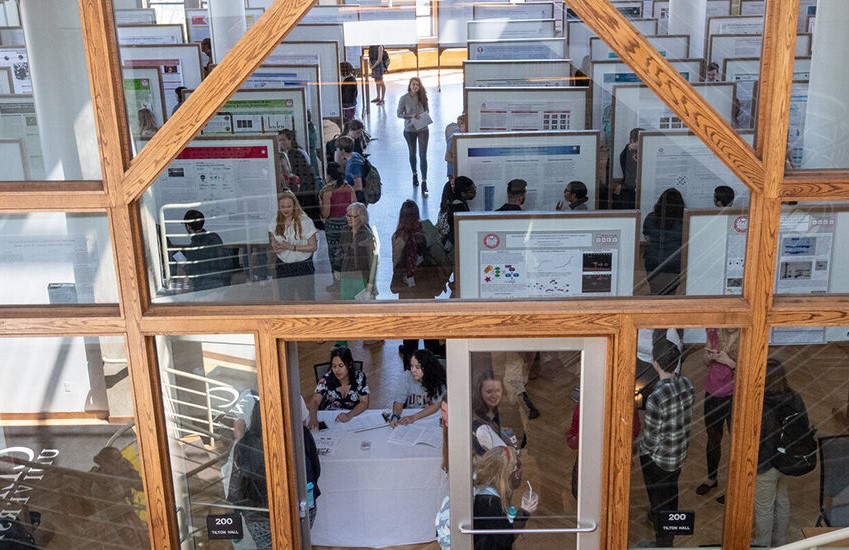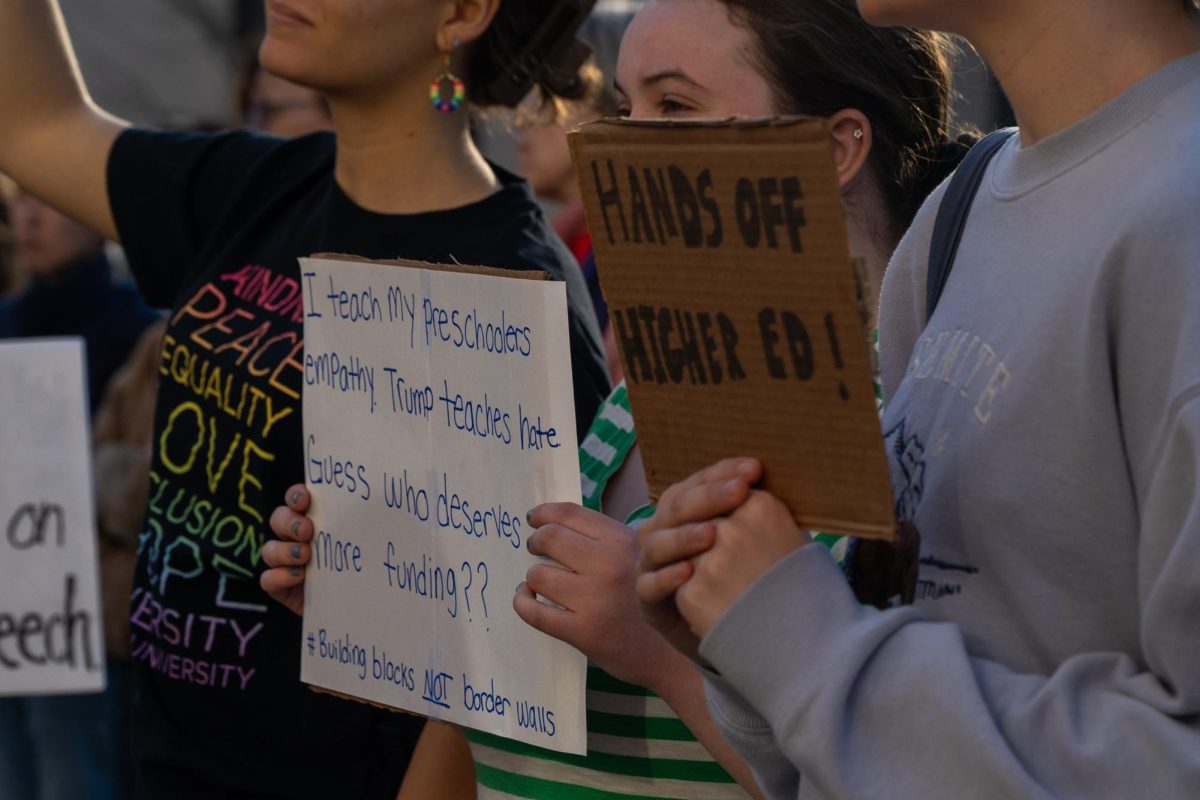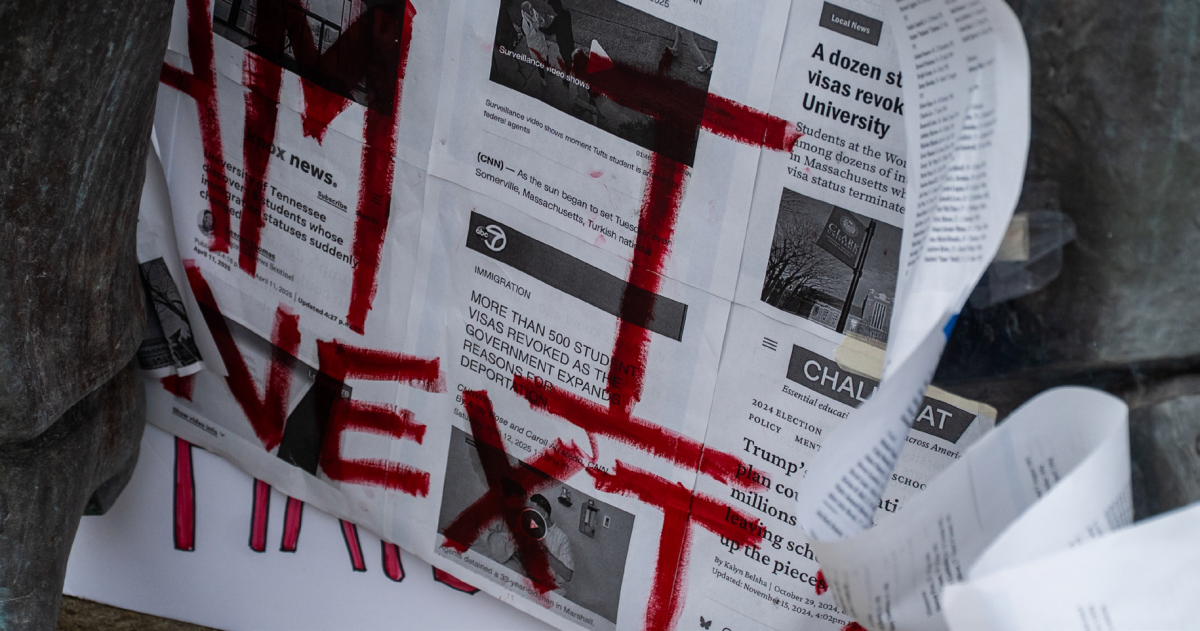In the early afternoon, Tilton Hall was bustling with people. Presentation posters filled the room, displaying students’ progress on some of the most interesting research projects, art displays and internships they’ve participated in. The atmosphere was invigorating, with the presenters eager to share their work and knowledge with the Clark community. This is ClarkFEST – an annual fall tradition, this year on Wednesday, Oct. 25 – where students have the opportunity to showcase their academic research, internship experiences and creative projects through posters and spoken presentations. Over 50 students presented, and the number of students and faculty in attendance was even higher. There was even an adorable service dog, a much-needed respite from the flurry of activity. Topics ranged from scientific research on fungi, Italian Renaissance art, political internships and photography projects.
Some students, like Zee White, presented projects in line with their career goals. “This Summer, I worked at the Cape Access Media Center. I want to eventually pursue a career in TV so during the internship, I learned how to edit, properly set up cameras, microphones and lights,” said White.
When asked about her typical day and the process of putting together each TV segment, White said, “we would go into the video center three days a week and we would spend time setting up sets.” Next, the team would start “changing lighting, moving tables, checking audio, camera angles… and then we would review the script that the customer sent us,” she said. “Then, we would take that footage and spend many hours editing the music and other graphics that the customer wanted, and any other changes that they wanted us to make for the final product.” White’s fondest memories from the experience all involve meeting the other interns. “It was a small group for the majority of the summer, so we really got to know one another, as well as everyone else working in the building,” she said. “It’s a really great community.”
An equally enthusiastic presenter was Jasper Carleton, who presented their research on fungi. “I work on a microfungus called Basidiobolus. It isn’t a species, it’s a genus, so there are species within it,” said Carleton. “This micro fungus lives in amphibian gastrointestinal tracts,” they added. “It’s been documented in a lot of places, generally more tropical climates. It’s also found pretty often in the Middle East.” This past Summer, Carleton’s research successfully documented evidence of the Basidiobolus fungi here in Massachusetts. The next step was to extract the specimens and send them to Novogene, a company that sequences DNA. “Once we get the DNA there, they send us back the results… and so what we get out of that is an assembly of a gene,” said Carleton. “And then, we can feed it through various other software, [and] we get statistics based on completeness and content.” Carleton’s work focused more specifically on secondary metabolites – organic material produced by the fungi that are not necessary for survival, but can help to provide a competitive advantage. “The [metabolite] that I find most interesting is called sevacidin, it’s sort of like an antimicrobial,” said Carleton. “It has a high similarity score to furacin equiset, and what’s weird is, that’s a parasite of honeybees. So why is it found in an organism that resides in amphibians?
Lily Summerfield also had a busy summer. She was named a Harrington Fellow – a public affairs program for Clark undergraduates interested in public policy – helping Summerfield secure an internship with Shenker Russo & Clark, a law firm based in Albany, N.Y. “They handle a lot of lobbying for unions, especially the New York State Pipe Trades Association,” said Summerfield. “I worked with lobbyists, and I had to help prepare for their big convention once a year. I wrote introductions, research and legislative agendas. I got to work a lot with how legislation that had already been passed or had not been passed affected unions,” Summerfield said. She also conducted a thorough study of municipal permitting, looking specifically at whether Walgreens stores need special permission to sell alcohol. “I called 4,822 places and addresses and double checked that the town required or did not require permits,” said Summerfield. Large companies like Walgreens have the means to hire law firms like the one Summerfield worked at to ensure their compliance with municipal codes, she said. “But the local businesses can’t – and it’s unfair to have that expectation placed on them,” she said.
Some presenters, like Carter Lee, faced barriers when it came to receiving the funding they needed to begin their projects. For their work, Lee put together an art project titled “Belonging,” a photographic exploration of their Korean heritage. “Belonging is a photobook that explores the complexities of community as a queer, trans, first-gen Korean American,” said Lee of their project. “I had applied for funding and didn’t get it, so I met with my mentors and reevaluated, because I really wanted to do it and it was very personal to me.”
Lee’s hope was to travel to Los Angeles to take photographs of Koreatown. On the table near Lee’s big poster was the final product: a photo album they designed themself. “My family has dozens of family photo albums,” said Lee, “so I began going through those and digitizing my family photos, and then I started making a book.”
When asked about their process for constructing it, Lee said, “I started to sort images by making connections between them, whether it’s due to the familial context, the colors in the photos, or the composition of them.”
When explaining why they chose a photography-based project, Lee said, “photography as a medium transcends language barriers; it speaks volumes without saying a single word.” Lee believes that this makes their project accessible to viewers in ways that projects in other areas of academia may not be. “Art invites people of all backgrounds and abilities to participate in both creating and sharing,” said Lee. “I hope my work will inspire artists to challenge academics’ perspectives on what valid research is.”
Lee was glad to be featured at ClarkFEST, and was especially proud that their work broke the mold. “I think there should be more opportunities for artists to secure funding to pursue these types of projects. There’s lots of different types of knowledge and lots of ways to express it.”
As Lee’s project exemplifies, the variation in which Clark students engage with knowledge is one of our biggest strengths as a university. When discussing how they became involved in researching fungi, Jasper Carleton said, “I came in as a bio major, but I got really lucky because I saw this research on the TV in a building. So, I took a leap of faith and just emailed the professor that was doing it. So we had a meeting, and I started working in the lab, and it’s been about two, or two and a half years.”
Zee White suggested that being proactive is key when it comes to landing an internship in television and media. “I think the key is to start looking early, because positions will fill up quickly,” White said. “But don’t worry about things being perfect.
Ultimately, the process of learning is more important than the final product – and that should be one of the most crucial takeaways of ClarkFEST.



